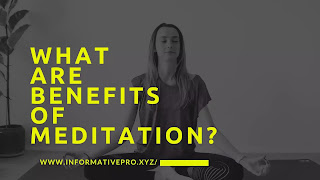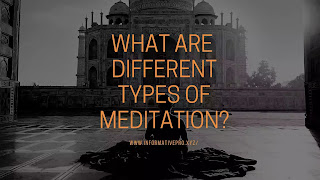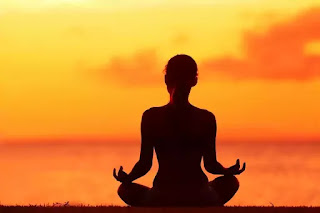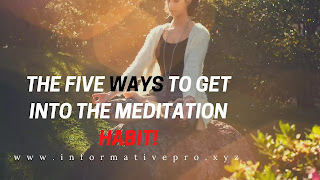How to meditate & feel stress-free at home?

Meditation is a very useful technique to train your mind.
According to Benson,
meditation is an opposite, involuntary response that causes a reduction in the activity of the sympathetic nervous system.”
Meditation is a mind
and body practice that has a long history of use for increasing calmness and
physical relaxation,
improving
psychological balance, coping with illness and enhancing overall health and
well-being.
Mind and body
practices focus on the interactions among the brain, mind, body, and behavior.
HOW TO MEDITATE: SIMPLE MEDITATION FOR BEGINNERS
This meditation exercise is an excellent introduction to
meditation techniques. You should practice it for 2-3 minutes and should
gradually increase your time period and this is the simple ways to meditate.
1. Sit or lie comfortably in a chair. (find a comfortable seat)
2. Close your eyes.
(relax your mind)
3. Start simply
breathing naturally. ( attention to
breath)
Focus your attention on the breath and on the movement of
your body with each inhalation and exhalation. You should notice the movement
of your body as you breathe. Observe your chest, shoulders, rib cage, and
belly. Focus your attention on your breath without controlling its pace or
intensity.
WHAT ARE BENEFITS OF
MEDITATION?

According to Buddhist philosophy, the ultimate benefit of
meditation is the liberation of the mind from attachment to things it cannot
control,
such as external circumstances or strong internal emotions.
Here are the several benefits of meditation listed below.
Meditation benefits:
- Lowers your blood pressure
- Helps in improving blood circulation
- Lowers heart rate
- Less perspiration
- Slows the rate of respiration
- Reduces anxiety
- Lowers blood cortisol levels
- Helps to get more feelings of well-being
- Reduces stress
- Gives Deep relaxation
- Meditation almost certainly does sharpen your attention.
- It also makes our compassion more effective.
- improves mental health
- Mindfulness could have a positive impact on your
relationships. - slow down and break patterns of obsessive or compulsive
behavior.
WHAT ARE DIFFERENT TYPES OF MEDITATION?

There are different meditation styles that can be practiced
which suits you the best.
They are:
1. Focused Meditation

It is an excellent meditation type for the beginners and for
them struggling for focusing a bit extra.
Focused meditation is a kind of
meditation that concentrates on any of the five senses. It may include other
aspects also, such as focusing on sounds or touch.
In focused meditation, you
should to concentrate on the flow of your breath – as it moves in and out of
your body and pulses energy throughout the same.
2. Spiritual Meditation
Those who thrive in silence and are looking for spiritual
growth should try it. Spiritual meditation is similar to that of prayer.
It
includes various elements to help you reach a very reflective and contemplative
state.

In spiritual meditation, you should embrace the silence around you and
slowly begin to let your mind wander to an internal prayer or question.
You may
find that the answer to your deepest question coming from outside yourselves
through the Divine, God, or Universe.
You also find that it simply allows you
to be comfortable within the silence that brings the answer within yourselves.
3. Mantra Meditation
If you dislike silence and find peace in repetition you
should try it out.
Despite popular belief, silence isn’t the only way to
meditate. This meditation uses a repetitive sound or set of sounds to clear the
mind.

By reciting or chanting a mantra, your mind is able to focus on the
rhythmic song and release the stressors of the day. With a long tradition in
meditation, mantras can be sung loudly or whispered quietly.
You can use an
inspirational phrase or even a simple onomatopoeia like “Om” or “Aum.”
Meditation is subjective and there’s no one right technique – it all depends on
what the experience means to you personally.
4. Transcendental Meditation
If you are looking for more structured meditation practice
or if you are new to the meditation but serious about maintaining the practice,
it is the best way you should look for.
This meditation practice was founded by
Maharishi Mahesh Yogi. It is the most popular type of meditation.

It uses a
mantra or series of Sanskrit words that help you to focus during meditation in
lieu of just the following the breath. Transcendental meditation organized and
structured practice of meditation.
It is a simple, natural, effortless
procedure which should be practiced 20 minutes twice each day while sitting
comfortably with the eyes closed.
5. Movement Meditation
If you find sitting still to be a distraction, peace through
action, or tired of sitting at a desk all day you should try this out.
It is
one of the fairly broad category of meditation. Movement meditation is the
active branch of meditation and incorporates some form of motion.

Movement
meditation utilizes walks through the woods, yoga, gardening, or even basic house cleaning to clear the mind.
By allowing the gentle movements to guide you,
your mind is free to wander and explore within itself. Thus, you should prefer
doing the movement meditation.
6. Mindfulness Meditation
Mindfulness meditation is an ongoing life practice. Less of
a separate activity and more a type of lifestyle, mindfulness meditation has
been originated from Buddhist teachings and teaches you to address and release
stress at the moment it is happening.

It promotes focused attention and
observation of the world immediately around you and nurtures a tone of
surrender to that which you cannot change.
This daily meditation practice is
generally best for those who don’t have access to a regular teacher as it can
be practiced alone.
WHAT ARE THE FIVE WAYS TO GET INTO THE MEDITATION HABIT?

Here are the five ways you can reap the benefits of regular
meditation practice or learning to meditate correctly:
1. Do it the same way every time:
You should meditate at the
same time every day and should repeat the same small rituals. If we do the same
thing in response to the same cue for a while, it becomes automatic
2. Start small:
You should make a promise that you can keep,
and start working from there. When you meditate the same way two mornings in a
row, even if it’s for a short time, you’re already building a good habit.
3. Sit with people:
It is excellent to sit with your partner
to build a regular meditation practice. Being a regular meditator is sharing
the practice with others—with your friends, with your family, with your fellow
travelers on the spiritual path, with everybody in the world.
Sitting with a
group regularly could be a great support to your daily practice at home as
everybody is there with the same with which you are.
4. Don’t expect anything special:
You should not expect
that when you sit and meditate for the first time you will achieve inner peace.
Meditation will often feel hard, and it is always unpredictable, but you must
not be frustrated by that.
Trying to meditate is meditation, and in that sense,
it’s very easy to do so.
If you sit down and try to interrupt your own
daydreaming and try to be conscious of your presence in the room for half an
hour, you will achieve something very good.
5. Enjoy it:
You should find a way to enjoy meditation so
that you can keep coming back on the same.
Meditation should be aesthetically
and physically pleasurable to you.
When
you sit down, search your senses for a sound or smell you enjoy, or some part
of your body that feels good, and let a bit of your mind rest there.
(FAQ):
Q.1: How to meditate before sleep?
Ans: Find comfortable sit after all you need to focus on you mind then feel relax like claim down your mind from other things after this relax your body and close you eyes and start breathing slowly. start to feel your breathing pattern and focus on it. it is helps to avoid insomnia and you will get good sleep.
Q.2: What are the Benefits of meditation for stress?
Ans: There are several benefits like :
1. Reduce anxity 2.Reduce stress 3. Lower heart rate 4. improve blood circulation 5. improve mental health.
Q.3: Can meditation be dangerous?
Ans: No, not at all because it is helps to your mental health and other inner parts work well. after meditation you will feel relax and focus. this is always improve your power of mind and inner health.
Q.4: What are the 3 types of meditation?
Ans: There are many types of meditation :
1. Mantra meditation 2. focused meditation 3. Movement meditation
Q.5: Can we experience the 4th dimension by meditation
according to Hindu cosmology?
Ans: Yes, according to Hindu cosmology said that the meditation is one of the portal to experience the 4th dimension. there are many states of meditation that give you these types of experience. example when you sleep after some time you feel the darkness vision of your mind and suddenly you wake up in other world like mid of ocean and feel everything you want from this.
Q.6: Is there any meditation technique that helps to go into
deep meditation?
Ans: Yes, there are lots of meditation technique which help to go into a deep meditation state but it is impossible for comman human because for this you need lots of focus and control on mind and need place near to nature and connect with nature without external disturbance. 1. Focused meditation 2. Mantra meditation 3. mindfulness meditation.

Leave a Reply